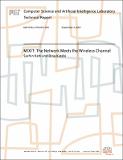| dc.contributor.advisor | Dina Katabi | |
| dc.contributor.author | Katti, Sachin | |
| dc.contributor.author | Katabi, Dina | |
| dc.contributor.other | Networks & Mobile Systems | |
| dc.date.accessioned | 2007-09-06T15:41:48Z | |
| dc.date.available | 2007-09-06T15:41:48Z | |
| dc.date.issued | 2007-09-04 | |
| dc.identifier.other | MIT-CSAIL-TR-2007-046 | |
| dc.identifier.uri | http://hdl.handle.net/1721.1/38871 | |
| dc.description.abstract | The traditional contract between the network and the lower layers states that the network does routing and the lower layers deliver correct packets. In a wireless network, however, different nodes may hear most bits in a transmission, yet none of them receives the whole packet uncorrupted. The current approach imposes fatesharing on the bits, dropping a whole packet because of a few incorrect bits. In contrast, this paper proposes MIXIT, a new architecture that performs opportunistic routing on groups of correctly received symbols. We show using simulations driven with Software Radios measurements that MIXIT provides $4$x throughput improvement over state-of-the-art opportunistic routing. | |
| dc.format.extent | 6 p. | |
| dc.relation.ispartofseries | Massachusetts Institute of Technology Computer Science and Artificial Intelligence Laboratory | |
| dc.subject | Network Coding | |
| dc.subject | Opportunistic Routing | |
| dc.subject | Co-operative Diversity | |
| dc.title | MIXIT: The Network Meets the Wireless Channel | |
